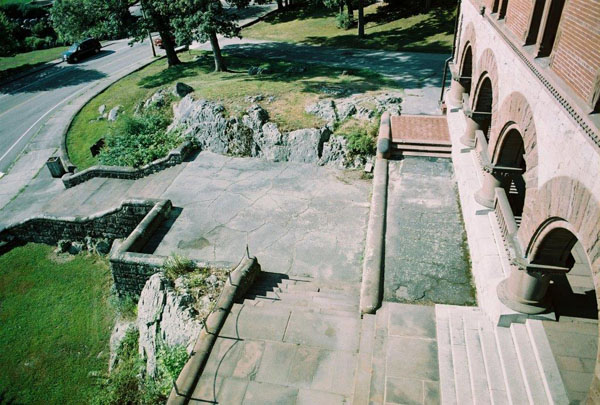
Oakes Ames Memorial Hall, which brings together the design brilliance and artistry of two Gilded Age superstar architects – Henry Hobson Richardson (aka H.H. Richardson) and Frederick Law Olmsted (aka F.L. Olmsted, and F.L.O.) – is among the most grand and magnificent properties in America.
It is also one of the most preferred and popular special event and meeting spaces in Metropolitan Boston.
Then, again, it would almost have to be – with the building designed by H.H. Richardson, who is considered, along with Frank Lloyd Wright and Louis Sullivan, a component of the Trinity of American Architects; and with the grounds of the property planned by F.L. Olmsted, widely called the Father of American Landscape Architecture.
Construction on the building and grounds began in 1879 and finished in 1881.
Architectural and design students and enthusiasts from the world over travel to North Easton Village to view, in person, and to photograph, Oakes Ames Memorial Hall – as well as the broader trove of Gilded Age architecture and artistry in the village, including four more H.H. Richardson buildings, more F.L.O. landscapes, and also the works of Augustus Saint-Gaudens, John La Farge, and Stanford White.

In this space we featured a post which calls attention to that Frederick Law Olmsted does not receive his due in terms of his contributions to the Oakes Ames Memorial Hall, with the massive, and ornately and beautifully designed, Richardsonian Romanesque edifice commanding most of the attention.
As well, we have posted here on the design and style elements that F.L.O. most widely and frequently used in his landscapes.
F.L.O.’s landscapes are found across the nation; his primary signature creations are Central Park in New York City, the grounds of the U.S. Capitol, the Emerald Necklace in Boston, and the grounds of the World’s Columbian Exposition (aka the 1893 Chicago World’s Fair).
Today, we call specific attention to one of the elements – prominent at Oakes Ames Memorial Hall, and found in many places Mr. Olmsted designed: the terraced stone staircase.
The staircase – which leads from the street to the hall entrance, is a series of four of wide steps connected to four terraces, bordered by banisters and walls, and set against natural rock outcroppings – sublimely complements and commends the stately … the awe-inspiring … expanse and rise of Mr. Richardson’s building.
“The stairs are beautiful and an architecturally significant unto themselves,” said Fred Ames, president of the Oakes Ames Memorial Hall board of trustees, and a descendant of the man for whom the building is named. “Many people, though – even if they know that Frederick Law Olmsted designed the grounds of the property, think that H.H. Richardson designed the stairs.”
Frederick Law Olmsted is a giant in planning and designing of America.
His genius is found throughout our republic – including at Oakes Ames Memorial Hall.